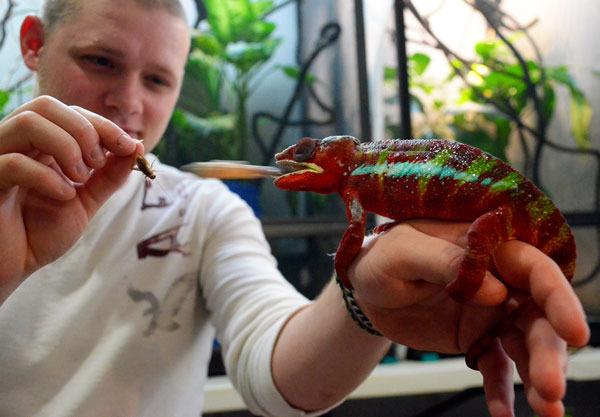Oak Harbor resident Chris Klieman has always been into what some call “the creepy crawly.”
Not so much bugs, but cold-blooded reptiles.
Scaly or slimy, he loves them both.
While they make some people shudder, for Klieman they have been a source of fascination for as long as he can remember.
He was that child on the playground who made the girls squeal by catching a snake and letting it wrap around his arm. Much of his youth was spent peering into dark crannies or navigating scummy ponds on an inflatable pool lounger in hopes of snatching up a frog.
His interest only grew with time and, in fourth grade, things changed forever.
Flipping through a book, he came across a picture of a chameleon. One glance at its brightly colored, nearly florescent green skin, bulging eyes and mitt-like hands and Klieman, 24, was hooked.
“I thought they were the coolest thing I had ever seen.”
He bought his first veiled chameleon when he was 9. Today, he is something of an at-home geneticist and is counted among a small pool of respected selective breeders in the state.
Specializing in panther and veiled chameleons, he is known for producing both beautiful and healthy specimens that range in price from $120 to $500.
But they don’t go to just anyone.
“I’m very picky about who I sell my chameleons to,” Klieman said.
“I want the best for them,” he said.
Chameleons are finicky creatures and require a higher level of care than the family dog. They must be kept in a regulated temperature, need ultraviolet lighting for vitamin D, and cages must be made of screen. Glass aquariums are a big no.
And that’s just living conditions.
They don’t drink water from a bowl but get it from droplets on leaves. That means the leaves need to be sprayed regularly, but not too much because excessive moisture can lead to other problems.
Their diet is specific as well.
Crickets and worms — both silk and goliath — are staples for chameleons, but local fare won’t do as they can have parasites. They must be ordered from special suppliers.
Klieman’s chameleons also dine on mantids, such as praying mantises.
Most of his customers come from clients met at reptile expos or hobbyists with experience, though he’s not absolutely opposed to newcomers.
He offers complete packages, which include all necessary equipment and information to get the inexperienced started.
In addition to being healthy, Klieman’s chameleons are beautiful and capable of a rainbow of colors, from sunburst yellow, super turquoise, fiery red and, of course, vibrants shades of green.
It’s all about genetics, Klieman said.
“If you breed two ugly chameleons, you’ll end up with an ugly chameleon.”
Sounds simple enough, but it’s no easy trick. It took Klieman years of trial and error to successfully mate two chameleons. It took longer to hatch a clutch of eggs.
Like adult chameleons’ diet and living conditions, their eggs require very specialized care and have an incubation period of nine months to two years.
Like many breeders, Klieman’s a little vague about explaining his methods. He keeps his techniques a closely guarded trade secret. He also declined to say how much he’s made from his home business, though the majority of profits are going into a college fund.
“Chameleons are just what I do in my free time,” Klieman said. “My interest is everything about animals; where they come from, how they survive.”
“This is a means to something bigger,” he said.
Klieman said he hopes to earn a master’s degree in wildlife conservation and, perhaps, follow the examples of great naturalists, such as Jeff Corwin and the late Steve Erwin, with his own television series.
Any future program of Klieman’s will no doubt be a little different, however, as he is no naturalist. In fact, he’s a Sunday school teacher who doesn’t believe in the theory of evolution.
He said his religious beliefs may make that goal a little more challenging but he’s not worried about it being an insurmountable obstacle.
Corwin and Erwin were successful because they made it easy and enjoyable to learn about animals, and he shares that same passion.
“If you’re not having fun, you’re not learning,” he said.
Klieman said he is looking at schools in California and Massachusetts and is pretty good about saving money, though things occasionally get in the way.
For example, when asked about the race-car parts scattered around his garage, a guilty smile crept over his face.
“That’s another hobby.”
Klieman will be speaking to Homeschoolers on Whidbey at 7 p.m. Monday, May 13, at Oak Harbor Lutheran Church. The event is open to the public.



